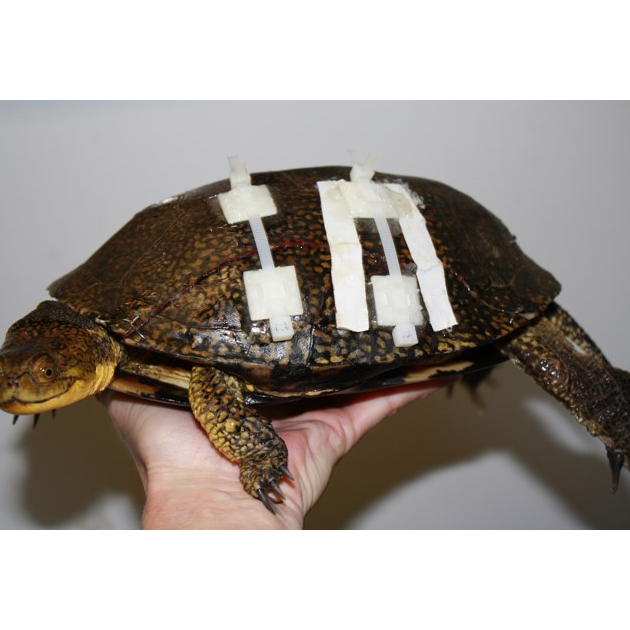
TURTLES IN TRAUMA - NETWORK OF VOLUNTEERS IS DEVOTED TO OVERCOMING DECLINING POPULATION
Article by John Challis
A female snapping turtle won’t lay her first eggs until she’s almost 20 years old. She could live more than a century, scraping a nest in sand or gravel early each summer to lay up to 50 eggs.
But because of a staggeringly high mortality rate, it’s estimated she will need to lay 1,500 eggs to produce just two surviving adult turtles to succeed her and one mate.
It’s the same for all eight of Ontario’s turtle species. They’re having a hard time keeping up their numbers, and several species are listed as endangered. Much of their wetland and forest habitats have been lost to human development. Nests laid in roadside gravel or people’s lawns are easy pickings for coyotes, raccoons and foxes.
And there’s road mortality: In Muskoka, where cottage access roads weave a web of hazards, the rate of vehicle injuries to turtles is high. When you see a turtle at the side of the road oozing blood through a cracked shell, you’re witnessing the visible evidence of population decline.
Unless, like a growing number of people, you offer a helping hand.
Turtles have remarkable healing powers, and given some gentle care, a turtle that seems beyond hope can be healed and back in action in eight to 12 weeks.
In Muskoka, about a dozen local veterinarians here are trained as “first responders.” They stabilize injured turtles and send them to the Ontario Turtle Conservation Centre (OTCC) in Peterborough for full medical treatment. At the centre, thousands of surgeries (a record 1,498 last year) are performed on turtles from across the province. The conservation centre also incubates turtle eggs that have been transferred from vulnerable nests – last year the centre received 6,000 eggs for incubation.
Dr. Sue Carstairs, who runs OTCC, says a disproportionate number of calls originate from Muskoka, so she was especially keen on recruiting help here.
Dr. Greg McWatt of the Animal Hospital in Gravenhurst, a former veterinary school classmate of Carstairs, took up the challenge. But it was his veterinary technician, Candace Vlietstra, who became hooked.
“She (Carstairs) came up and demonstrated how to look after injured turtles,” Vlietstra says, “and she showed some pictures and procedures at the centre. And I kind of fell in love with it.” This is her third summer tending to turtles at the clinic. “It’s a very rewarding experience; it really is quite a pleasure to work with Sue Carstairs and her team.”
In her first year she took in a very large snapping turtle which was late for winter hibernation. It had severe frostbite over most of its body. For more than a day, it remained in a stupor. Vlietstra took it home overnight to monitor it. On the drive back to the clinic the next day, the turtle escaped from its tote and clambered up onto the centre console beside her. “I screamed,” she says with a laugh. Dudley, as she named him, remained an escape artist, frequently sneaking out of its tub at the OTCC. In a month, Dudley was well enough to release back to its home wetland.
As a first responder, Vlietstra needs to triage her patients.
“The first thing I’ll do is get a weight for the turtle,” she explains. “Then I get fluids into it, under the skin, and then we administer pain and anti-inflammatory medication. I tape up the shell so it won’t move around … it can be quite painful. They’ll get fluids three or four times a day.” If there is an open hole, she’ll fill it with gauze.
“If it’s too late to deliver, or on the weekend, I’ll take it home for a sleepover,” Vlietstra adds.
Already this year, their clinic has received 20 turtles. She agrees the annual injury rate in Muskoka might be due to summer traffic on backroads. However, the high numbers may also be because more people with greater awareness and concern for the welfare of turtles are calling.
“We received close to 200 (turtles) last year,” she adds. “On one trip, I took 18 turtles in the car to Peterborough. And I came home with two clutches of 75 hatched young ones – 150 in all — and released them.”
At the Ontario Turtle Conservation Centre, Dr. Carstairs relies on a network of hundreds of volunteers who act as ambulance drivers, feed and clean the turtles in the centre, conduct research and, with special provincial permits, retrieve eggs. There are many other like-minded organizations linked to OTCC as well. Scales Nature Park in Orillia, partnered with START (Saving Turtles At Risk Today), has permits to retrieve eggs.
Found an injured turtle?
If you find an injured turtle, it’s wise to wear gloves when you pick it up. Place the turtle in a clean, dry tub with a towel or blanket under it, and keep it in a quiet area. Call the Ontario Turtle Conservation Centre in Peterborough, at 705-741-5000. The OTCC will quickly assess who’s available in your area, and connect you with an available veterinarian to make arrangements for the drop-off – usually on the same day.
Families are normally invited to witness the successful release of a healed turtle, or a clutch of raised young. This year’s social distancing has ruled that out but families are always informed of the outcome of their rescue.
Recently, Candace Vlietstra had a visit from two young boys who brought in a turtle with a slight cut to its leg. It wasn’t much, she said, but the boys were upset.
“It’s bleeding!” they told her in distress. “I told them I was so proud of them and they were so good to bring it in.” The cut healed in two weeks, and the boys’ little patient was discharged from hospital and sent back out to its pond. Another happy ending for both warm and cold-blooded animals.
